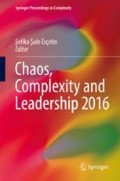Abstract
This study was conducted taking into account the chaotic situations that frequently occur in schools in Turkey. Within the scope of the study, 34 “teacfhers who work in the kindergartens in Yozgat in 2016–2017 academic year were asked about the situations that would create chaos in their classes.” Class environments are social constructs in which chaotic situations can emerge, and leaders may emerge depending on the starting points of these chaotic situations. When the circumstances are considered in this context, it is not possible to predict when a preschool class will go into chaos, who can assume the leadership role accordingly, and the consequences of these situations. Given the chaotic situations of the classes in this study, games were prepared taking into account the “processes that are expected to be drawn in the leadership profile” of Erçetin ŞŞ, Açıkalın ŞN, Bülbül MŞ (2013). A multi-dimensional approach to leadership in chaotic environments. In: Chaos and complexity theory for management: Nonlinear dynamics in the “Multidimensional Approach to Chaos Environment and Leadership” studies.
Access this chapter
Tax calculation will be finalised at checkout
Purchases are for personal use only
References
Acuner, T. (2002). Lider Doğulur mu? Olunur mu? Standart Dergisi, Mayıs, 63–66.
Adair, J. (2004). Etkili Liderlik,Liderlik Kabiliyeti Nasıl Geliştirilir. İstanbul: Babıali Kültür Yayıncılık.
Aral, N. (2000). Çocuk gelişiminde oyunun önemi (p. 265). Ankara: Çağdaş Eğitim.
Aydın, M. (2014). Çağdaş Eğitim Denetimi. Ankara: Gazi Kitabevi.
Baker, S. B. (1995). Chaos theory in educational systems; principals’ perceptions of sensitive dependence on initial conditions. Unpublished doctoral dissertation East Tennessee State University.
Cvetek, S. (2008). Applying chaos theory to lesson planning and delivery. European Journal of Teacher Education, 31, 247–256.
Dobrzanska, A. (2005). ACA Leadership development training: becoming the effective leaders of tomorrow. Corrections Today, 67, 6.
Erçetin, Ş. Ş. (2000). Lider Sarmalında Vizyon. Nobel Yayıncılık Ankara.
Erçetin, Ş. Ş. (2001). Yönetimde Yeni Yaklaşımlar. Ankara: Nobel Yayıncılık.
Erçetin, Ş. Ş., & Kayman, E. A. (2014). How to be a quantum leader in an intelligent organization? In Ş. Ş. Erçetin & S. Banerjee (Eds.), Chaos, complexity and leadership 2012. Dordrecht: Springer.
Erçetin, Ş. Ş., Açıkalın, Ş. N., & Bülbül, M. Ş. (2013). A multi-dimensional approach to leadership in chaotic environments. In S. Banerjee (Ed.), Chaos and complexity theory for management: Nonlinear dynamics (pp. 89–104). Hershey: IGI Global. https://doi.org/10.4018/978-1-4666-2509-9.ch005.
Erçetin, Ş. Ş., Bisaso, S. M., & Saeed, F. (2015). Understanding chaos and complexity in education systems through conceptualization of fractal properties. In Ş. Ş. Erçetin & S. Banerjee (Eds.) http://link.springer.com/book/10.1007/978-94-007-7362-2. Chaos, complexity and leadership 2013. http://link.springer.com/bookseries/11637. Springer proceedings in complexity, Ch 12 (pp. 147–161). https://doi.org/10.1007/978-3-319-09710-7_12
Erçetin, Ş. Ş., Hamedoğlu, M. A., & Açıkalın, S. N. (2014). Can managerial narcissism which likely leads to a chaotic process be measured? Managerial Narcissism Scale (MNS). In Ş. Ş. Erçetin & S. Banerjee (Eds.), Chaos and complexity in world politics (Vol. 7, pp. 89–104). Hershey: IGI Global.
Gleick, J. (2000). Kaos. (Çev.Fikret Üçcan) (Vol. 15, p. 8). İstanbul: Tübitak Popüler Bilim Kitapları. Baskı.
Karaçay, T. (2004). Determinizm ve Kaos, Mantık, Matematik ve Felsefe II.Ulusal Sempozyumu Tema: Kaos,Assos, 21–24 Eylül.
Mutlu, A., & Sakınç, İ. (2006). Yönetimde Kaos. İstanbul: İstanbul Kültür Üniversitesi Yayınları.
Neyişçi, N., & Potas, N. (2014). Avoidance behaviors of school managers in uncertain and chaotic environments. In S. Banerjee & Ş. Ş. Erçetin (Eds.), Chaos, complexity and leadership 2012 (pp. 219–227). Germany: Springer.
Northouse, P. G. (2014). Liderlik Kuram Ve Uygulamaları, SAGE, 6.Baskıdan Çeviri,Sürat Yayınları.
Peterson, K. D. (2001). Principals’ work, socialization, and training: Developing more effective leaders. Theory into Practice, 25, 3.
Radford, M. (2006). Researching classrooms: Complexity and chaos. British Educational Research Journal, 32(2), 177–190.
Smith, A. C. T., & Humphries, E. C. (2004). Complexity theory as a practical management tool: A critical evaluation. Organization Management Journal Linking Theory & Practice, 1(2), 91–106.
Töremen, F. (2000). Kaos Teorisi ve Okul Yöneticisinin Rolü, Kuram ve Uygulamada Eğitim Yönetimi Bahar 22.
Trygestad, J. (1997). Chaos in the classroom: An application of chaos theory. Roundtable Session of Chaos and Complexity Theory. American Educational Research Association. University of Minnesota. March 24–28, 1997. www.eric.ed.gov (Eric Documant: 413289).
Vries, K. M. (2007). Liderliğin Gizemi. İstanbul: Prentice Hall Financial Times, BZD Yayın.
Wheeler, D. D. (1989). Problems with chaotic cryptosystems. Crvptologia, XIII(3), 243–250.
Author information
Authors and Affiliations
Corresponding author
Editor information
Editors and Affiliations
Rights and permissions
Copyright information
© 2018 Springer International Publishing AG, part of Springer Nature
About this paper
Cite this paper
Ertaş, B. (2018). In Chaotic Situations in Preschool Institutions, Do Leaders Reach Through the Game?. In: Erçetin, Ş. (eds) Chaos, Complexity and Leadership 2016. ICCLS 2016. Springer Proceedings in Complexity. Springer, Cham. https://doi.org/10.1007/978-3-319-64554-4_47
Download citation
DOI: https://doi.org/10.1007/978-3-319-64554-4_47
Published:
Publisher Name: Springer, Cham
Print ISBN: 978-3-319-64552-0
Online ISBN: 978-3-319-64554-4
eBook Packages: Business and ManagementBusiness and Management (R0)

